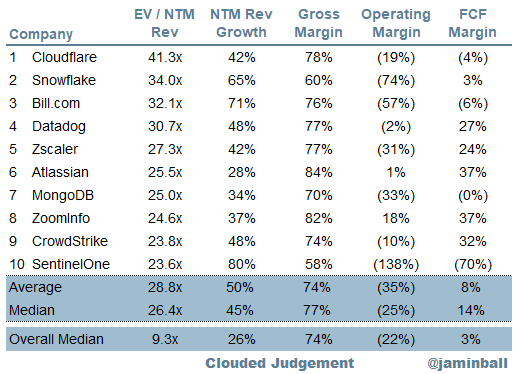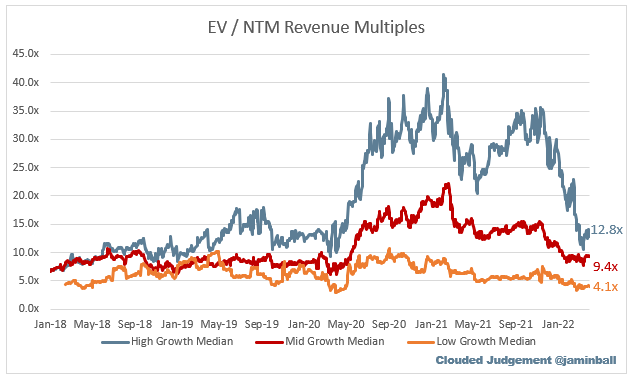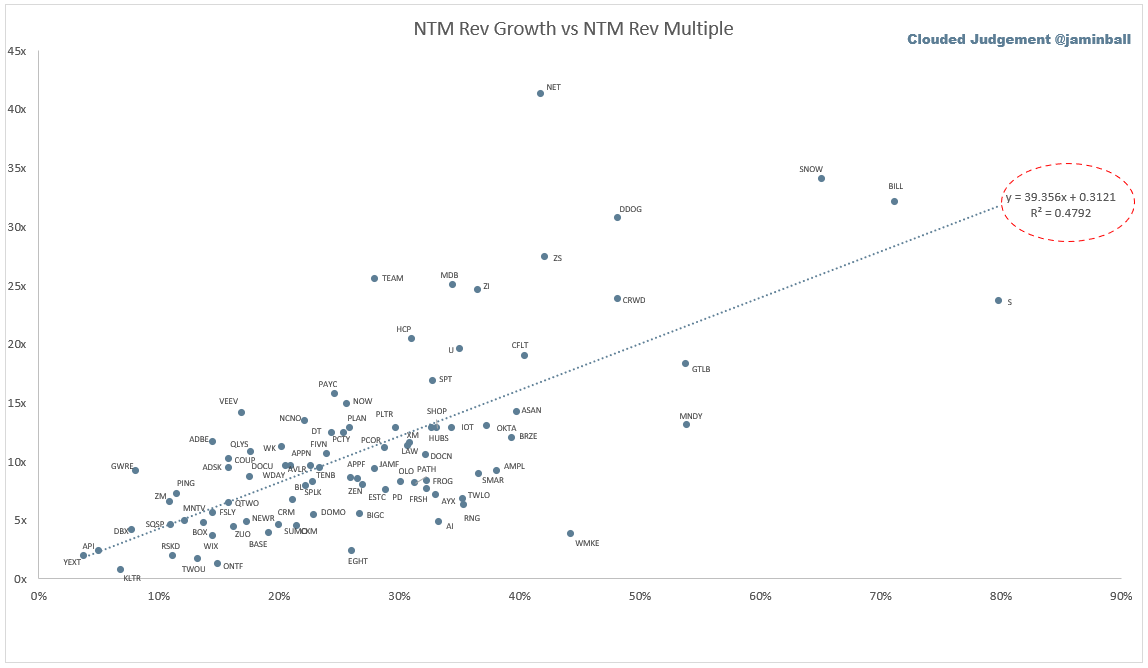Clouded Judgement 4.1.22
Every week I’ll provide updates on the latest trends in cloud software companies. Follow along to stay up to date!
Was the March Rally Real?
Cloud software stocks hit a local minimum in mid-march and then sharply bounced up 20% in the last 2 weeks of March. This came with the backdrop of a global war, rising inflation, a very hawkish Fed, and an impending recession that seems more likely every day. Hard to feel like the 20% jump was warranted. So was the bounce off the bottom mid March real or should we expect another leg down?
It’s a hard question to answer, but no matter what my long term views are (as everyone knows they’re bullish!) it feels impossible to be short term bullish. Software was in a unique position (for the most part) of actually benefiting from Covid. For most companies the business fundamentals actually improved! If we are headed towards a recession, we could start to see companies tightening their belts and reducing software spend. This is far from a foregone conclusion, but it’s a distinct possibility. If this happens we could see multiple compression driven by business fundamentals. A counter point to this is Morgan Stanley released their CIO Survey yesterday, and in it CIOs expect software spend to grow 4.8% in 2022. This is only slightly down from expectations in the Q4 2021 survey, and above the 5 year average of annual growth. One rationale cited was that while overall budgets may drop, software’s share of budgets is going up.
But back to the 20% jump to end March - was it real? Unfortunately I believe the answer is no. The jump came despite INCREDIBLY low trading volumes. Many institutional investors were not actually buying over the last 2 weeks. So what happened? A lot of shorts were put on given the macro backdrop and recent downward trend. Many of these came from algo funds. At the same time retail got HEAVILY involved with option trading (betting on upward movements). This pushed up stocks, and then we saw a short squeeze. To cover a short you have to buy the underlying stock, and when this happens repeatedly it drives the price up. And many algo shorts were covered! There really weren’t many incremental buyers of the stocks that shot up. However, sometimes rallies start like this. Many institutional investors would be “caught offsides” if a real rally started. What this means is most institutions have very low exposure to growth and growth software. They’re sitting on the sidelines. If growth started to rip up, no one would want to miss that prolonged rally. So they’d pile in to not miss the next swing up driving stocks up even further. I’m not convinced big institutions think the recent rally was real, so I’m not sure they care to be offsides for the last 2 weeks (or feel any pressure to get onside). There’s just too much macro uncertainty. So net net I expect a lot more volatility over the coming 2 quarters. I very strongly believe the last 2 weeks DO NOT give us growth investors the “all clear.”
Quarterly Reports Summary
Top 10 EV / NTM Revenue Multiples
Top 10 Weekly Share Price Movement
Update on Multiples
SaaS businesses are valued on a multiple of their revenue - in most cases the projected revenue for the next 12 months. Multiples shown below are calculated by taking the Enterprise Value (market cap + debt - cash) / NTM revenue.
Overall Stats:
Overall Median: 9.3x
Top 5 Median: 32.1x
3 Month Trailing Average: 9.9x
1 Year Trailing Average: 13.9x
Bucketed by Growth. In the buckets below I consider high growth >30% projected NTM growth, mid growth 15%-30% and low growth <15%
High Growth Median: 12.8x
Mid Growth Median: 9.4x
Low Growth Median: 4.1x
Scatter Plot of EV / NTM Rev Multiple vs NTM Rev Growth
How correlated is growth to valuation multiple?
Growth Adjusted EV / NTM Rev
The below chart shows the EV / NTM revenue multiple divided by NTM consensus growth expectations. The goal of this graph is to show how relatively cheap / expensive each stock is relative to their growth expectations
[chart]
Operating Metrics
Median NTM growth rate: 26%
Median LTM growth rate: 33%
Median Gross Margin: 74%
Median Operating Margin (19%)
Median FCF Margin: 4%
Median Net Retention: 120%
Median CAC Payback: 23 months
Median S&M % Revenue: 45%
Median R&D % Revenue: 26%
Median G&A % Revenue: 19%
Comps Output
Rule of 40 shows LTM growth rate + LTM FCF Margin. FCF calculated as Cash Flow from Operations - Capital Expenditures
GM Adjusted Payback is calculated as: (Previous Q S&M) / (Net New ARR in Q x Gross Margin) x 12 . It shows the number of months it takes for a SaaS business to payback their fully burdened CAC on a gross profit basis. Most public companies don’t report net new ARR, so I’m taking an implied ARR metric (quarterly subscription revenue x 4). Net new ARR is simply the ARR of the current quarter, minus the ARR of the previous quarter. Companies that do not disclose subscription rev have been left out of the analysis and are listed as NA.
This post and the information presented are intended for informational purposes only. The views expressed herein are the author’s alone and do not constitute an offer to sell, or a recommendation to purchase, or a solicitation of an offer to buy, any security, nor a recommendation for any investment product or service. While certain information contained herein has been obtained from sources believed to be reliable, neither the author nor any of his employers or their affiliates have independently verified this information, and its accuracy and completeness cannot be guaranteed. Accordingly, no representation or warranty, express or implied, is made as to, and no reliance should be placed on, the fairness, accuracy, timeliness or completeness of this information. The author and all employers and their affiliated persons assume no liability for this information and no obligation to update the information or analysis contained herein in the future.














I love these overviews. Is it possible to get the table with all SaaS stocks as excel file? Would appreciate that so much!
Love how you're blending in macro into the thought process.
I'd suggest tracking US 10y tsy rate vol (and vol of vol) if you're not already. You're going to see some very distinct rebalancing behavior in growth names starting, driven off fundamentals underlying US 10yr tsy volatility.